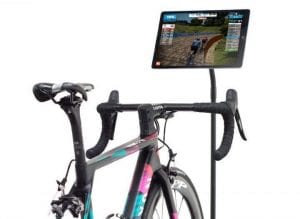UPDATE (9/1/16): you can now sign up to be a Zwift for iOS beta tester.
This is big, folks.
Zwift is now in pre-beta testing for iOS devices. The following devices will be supported (a 64bit A7 processor or greater is required):
 iPad Air 1 and 2
iPad Air 1 and 2- iPad Pro 9.7″ and 12″
- iPad mini 2, 3 and 4
- iPod 6th gen
- iPhone 5SE
- iPhone 6/6+/6S/6S+/SE
Performance notes
According to Shane Miller performance is silky-smooth, better than his Alienware Alpha desktop computer. Zwift has been touch-enabled for a while now, so you are able to simply the touch the screen to give Ride Ons, change settings, etc. And a simple lightning to HDMI cable will let you view Zwift on your TV while it runs on your iDevice.
Bluetooth only
Zwift on iOS will only support Bluetooth connections at this time, since iDevices do not have ANT+ built in. All true smart trainers support Bluetooth as well as ANT+, so this won’t be a problem on that front, but people using certain devices which only support ANT+ will need to purchase a Bluetooth to ANT bridge such as the Viiiiva heart rate monitor ($80US) so their ANT+ signals can be converted to Bluetooth.
What’s the big deal?
Arguably the largest single barrier to Zwift entry is on the computing side of things: many people do not have powerful enough computers to run Zwift smoothly, or at all. (Zwift requires Windows 7 64bit or higher or macOS 10.7 or higher, plus 4GB of memory and a fairly beefy graphics card.)
This move opens Zwift up to a massive new audience of folks who aren’t willing to make a huge investment in indoor training but already have a compatible iDevice and an indoor trainer. No ANT+ dongle needed: just pair your trainer to your iDevice and go! This is going to be huge.
When?
According to road.cc the app will be available in September with beta testing invites being sent out to the Zwift community. Zwift HQ is hoping to roll out the full app this winter.
Here’s an excellent “first look” video from everyone’s favorite lama from down under, Shane Miller:
And here’s a more in-depth writeup from James Gill, who maintains the unofficial Zwift user manual.

